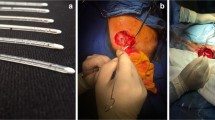Abstract
Purpose
Prove the concept of high-resistance proximal catheters for valve-independent treatment of hydrocephalus.
Methods
A preliminary design process yielded optimal high-resistance proximal ventricular catheters with a “scaled” design and parallel-oriented, U-shaped inlets. Prototypes were manually constructed using carving tools to stamp through silicone tubings. A testing apparatus was developed to simulate cerebrospinal fluid flow through a catheter, and the prototypes were tested against a control catheter for exhibition of an “on/off” phenomenon whereby no flow occurs at low pressures, and flow begins beyond a pressure threshold. Flow distribution was visualized with India ink. Regression analysis was performed to determine linearity.
Results
The new designs showed varying amounts of improved flow control with the “scaled” design showing the most practical flow rate control across various pressures, compared to the standard catheter; however, no true “on/off” phenomenon was observed. The “scaled” design showed various degrees of dynamism; its flow rate can be time dependent, and certain maneuvers such as flushing and bending increased flow rate temporarily. Variation in the number of inlets within each “scaled” prototype also affected flow rate. Contrastingly, the flow rate of standard catheters was found to be independent of the number of inlet holes. Ink flow showed even flow distribution in “scaled” prototypes.
Conclusions
This initial feasibility study showed that high-resistance ventricular catheters can be designed to mimic the current/valved system. The “scaled” design demonstrated the best flow control, and its unique features were characterized.







Similar content being viewed by others
Data availability
Not applicable.
Code availability
Not applicable.
References
Galarza M, Etus V, Sosa F, Argañaraz R, Mantese B, Gazzeri R, Montoya CG, de la Rosa P, Guerrero AL, Chaban G, Giménez A, Amigó JM (2020) Flow ventricular catheters for shunted hydrocephalus: initial clinical results. Childs Nerv Syst 37:903–911. https://doi.org/10.1007/s00381-020-04941-8
Galarza M, Giménez A, Amigó JM, Schuhmann M, Gazzeri R, Thomale U, McAllister JP (2018) Next generation of ventricular catheters for hydrocephalus based on parametric designs. Childs Nerv Syst 34:267–276. https://doi.org/10.1007/s00381-017-3565-0
Galarza M, Giménez A, Valero J, Pellicer OP, Amigó JM (2014) Computational fluid dynamics of ventricular catheters used for the treatment of hydrocephalus: a 3D analysis. Childs Nerv Syst 30:105–116. https://doi.org/10.1007/s00381-013-2226-1
Giménez Á, Galarza M, Pellicer O, Valero J, Amigó JM (2016) Influence of the hole geometry on the flow distribution in ventricular catheters for hydrocephalus. Biomed Eng Online 15:71. https://doi.org/10.1186/s12938-016-0182-1
Harris CA, McAllister JP (2011) Does drainage hole size influence adhesion on ventricular catheters? Childs Nerv Syst 27:1221–1232. https://doi.org/10.1007/s00381-011-1430-0
Lin J, Morris M, Olivero W, Boop F, Sanford R (2003) Computational and experimental study of proximal flow in ventricular catheters. Technical note J Neurosurg 99:426–431. https://doi.org/10.3171/jns.2003.99.2.0426
Thomale UW, Hosch H, Koch A, Schulz M, Stoltenburg G, Haberl EJ, Sprung C (2010) Perforation holes in ventricular catheters—is less more? Childs Nerv Syst 26:781–789. https://doi.org/10.1007/s00381-009-1055-8
Wetzel JS, Waldman AD, Texakalidis P, Buster B, Eshraghi SR, Wheelus J, Resiner A, Chern JJ (2019) Survival and failures trends of cerebrospinal fluid shunts with distal slit valves: comparative study and literature review. J Neurosurg Pediatr 25:209–216. https://doi.org/10.3171/2019.9.PEDS18579
Pollay M (2010) The function and structure of the cerebrospinal fluid outflow system. Cerebrospinal Fluid research 7:9–29
Bogdanovich PN, Tkachuk DV (2013) Polymer fatigue. Encyclopedia of Tribology. Springer, Boston, MA. https://doi.org/10.1007/978-0-387-92897-5_818
Acknowledgements
The authors appreciate the assistance of the Bradley University Department of Mechanical Engineering Senior Design Project teams for the academic year 2019–2020 including Amanda Wagner, Elisabeth Canum, Gloire Lokombe, Richard McAlister, and Kaleb Reecy and 2020–2021 including Concetta Gendusa, Jamie Goslin, Emily Baima, and Abby Leisure in catheter design, prototyping, and data collection.
Author information
Authors and Affiliations
Contributions
Not applicable.
Corresponding author
Ethics declarations
Ethics approval
Not applicable.
Consent to participate
Not applicable
Consent for publication
Not applicable
Conflict of interest
On behalf of all authors, the corresponding author states that there is no conflict of interest.
Additional information
Publisher's Note
Springer Nature remains neutral with regard to jurisdictional claims in published maps and institutional affiliations.
Previous presentations: 49th Annual Meeting of the AANS/CNS Section on Pediatric Neurological Surgery, Dec 3–5, 2020, Virtual Forum.
Electronic supplementary material
Below is the link to the electronic supplementary material.
Video 1. Ink flow through the “U” inlets which are well distributed throughout the length of the prototype catheter. A majority of flow occurs through the distal-most inlet from the proximal tip (MP4 3070 KB)
Rights and permissions
About this article
Cite this article
Qi, D., Olson, E., Ivankovic, S. et al. High-resistance proximal “scaled” ventricular catheters. Childs Nerv Syst 38, 333–341 (2022). https://doi.org/10.1007/s00381-021-05390-7
Received:
Accepted:
Published:
Issue Date:
DOI: https://doi.org/10.1007/s00381-021-05390-7




